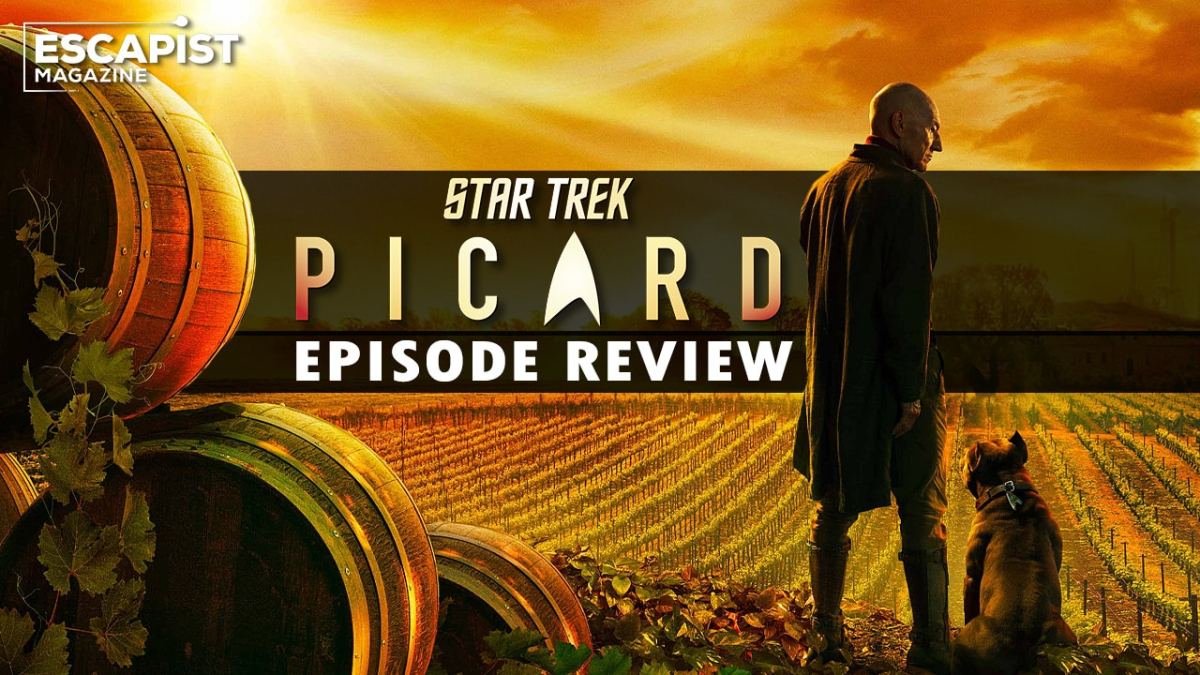This review contains spoilers for Star Trek: Picard, episode 5, “Stardust City Rag.”
Bruce Maddox, the character that presented one of the central mysteries of Star Trek: Picard, is dead. So why don’t I care?
Could it be that everything we know about his character comes secondhand? Or is it that we have been told how important Bruce Maddox was constantly without ever being shown it? When we first see the flesh-and-blood Dr. Maddox, who cares? He’s not really a character; he’s a human MacGuffin, and it’s impossible to relate when he only exists as a plot object.
It doesn’t matter how many times we see Agnes watching old home movies in scenes of hacky exposition and forced empathy. When he is on the operating table at the end of “Stardust City Rag,” there is no emotional resonance, even despite Alison Pill trying her very hardest to sell these emotions. I wish we saw more of Agnes and Bruce Maddox’s relationship earlier in the series, so we could at least begin to understand where she is coming from. Pushing all of that into this single episode makes us feel cheated, and it only serves to hurt the character development of all parties.
“Stardust City Rag” is at its weakest when tethered to the main overarching plot of this season. The subplot around Freecloud, however, is the best work I’ve seen so far, reminding me why I love Star Trek. I’ve written about how Star Trek: Picard presents big ideas and abandons them without a second thought, and this episode shows why that cowardice is so damaging to the show. This episode does what I wish the others would’ve done: It presents us with a huge idea and follows through in a nuanced, interesting way.

Seven of Nine was transported onto Rios’ ship at the tail end of the last episode. In “Stardust City Rag,” we learn that she’s been working with the Fenris Rangers, a vigilante organization that helps protect the areas of the galaxy the Federation abandoned. She doesn’t care about the law, as long as she can protect those most in need. This presents a conflict for Picard.
Earlier in the season, we learned that Picard was forced to abandon a rescue mission that would’ve saved countless lives because he was bound by the Federation’s insistence that the Romulans are enemies. This was a clear abandonment by an organization that had sworn to protect life throughout the galaxy. Till now, I’d been continually disappointed at the show’s seeming unwillingness to explore this topic. Seven of Nine’s plot is the exact kind of exploration that I was searching for.
When Starfleet abandoned the Romulan refugees, Picard saw no other choice but to resign in protest. Seven of Nine, however, decided to fight for those she wanted to protect, Federation be damned! To Seven of Nine, what good are laws when they refuse to help the weak? Her disillusionment didn’t manifest in a symbolic resignation, but in direct action.
This makes us further question whether Picard actually made the right choice when he retired, especially with the knowledge that he is currently on an unsanctioned mission working against Starfleet orders. Is Seven of Nine a version of Picard that might have existed had he chosen a separate path? Is that path the more righteous?
“Stardust City Rag” asks these questions and leaves us with answers that aren’t cut and dry. This is the reason I love Star Trek and love Jean-Luc Picard as a character.

Freecloud is a fantastic setting for these questions of morality. It is clearly borrowing the cyberpunk aesthetic and takes on an almost noir look whenever our crew is on this planet of constant overcast and shadow. For what the episode is trying to do with moral gray, the setting is inspired. Of course, this is also a good excuse to show a few new aliens, most notably a lizard man that can smell lies. It is wacky, odd, and I love it to death.
I’ve started to turn around on Rios’ holograms. In the first episodes featuring them, they felt chaotic and wrong. It was almost impossible to follow which one was which, and the inconsistent accent work didn’t help. In “Stardust City Rag,” these versions of Rios finally came into their own mostly because they were used sparingly. The medical hologram shows up a couple times, and it’s genuinely charming whenever he’s on screen. I just think the key is restraint. The wacky holograms can be fun, but they take you out of the episode incredibly fast. This is the first time I saw a utility for them.
On the other side of this episode, we continue with Raffi, who tries to visit her son. Since she’s a major character who can’t just disappear from the show, we know going in that this field trip to meet her son won’t end well. We know she’ll go right back to Picard, and any insistence to the contrary by Raffi is laughable. She still feels like an underdeveloped character, sabotaging any effort at emotional resonance as she meets with her distant son and his wife. The plot is brief, so it doesn’t actually take that much away from the episode. I just wish we cared about Raffi enough to feel her pain in abandoning her son and the sadness involved with him not wanting her to come back.

There’s an underlying theme of abandonment with all of these plots. Seven of Nine deals with the abandonment of Starfleet with violence and vigilantism. Picard abandoned Starfleet because Starfleet abandoned him. Agnes has had to deal with being abandoned by Bruce Maddox, a man that she clearly loved. In her eyes, you can even see that she has abandoned her notions of who Bruce Maddox was.
When I finished this episode, my first thought was about how good the pacing was. Then I realized that the theme of abandonment might inadvertently tie back to something they abandoned for this episode.
They never cut back to the plot with Narek and Soji.
This series has had an anchor chained to its leg, making it limp around, unable to hold my attention for extended periods of time. “Stardust City Rag” felt like the first episode where that anchor had been unchained and Star Trek: Picard was finally allowed to run headlong into the greatness that I always knew it had. Only one variable changed, and now I know for sure that Narek and Soji are that anchor. And even though I know we will have to deal with them again next episode, there’s a small part of me that hopes they just never mention them again.
This episode gives me hope, but knowing Star Trek: Picard, that hope won’t last much longer.





Published: Feb 20, 2020 03:05 pm